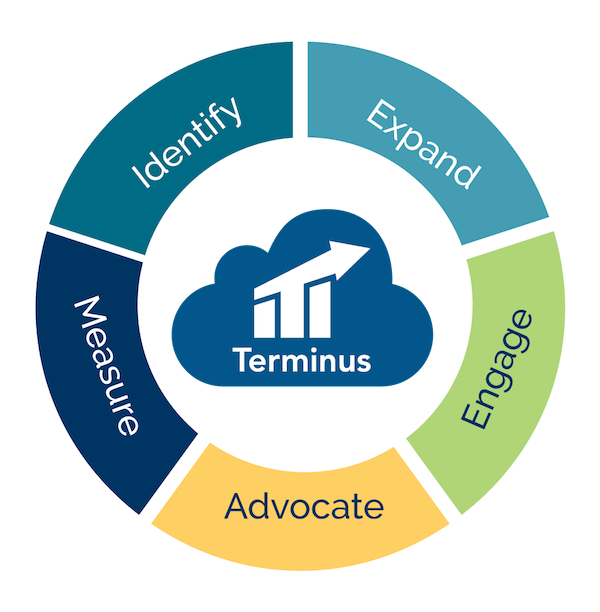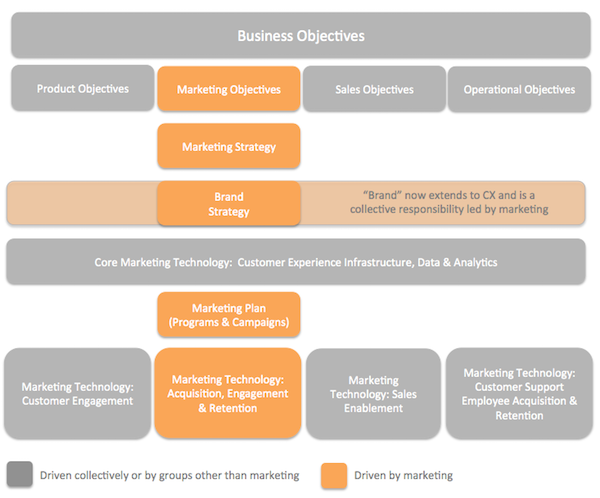This article is a guest post by Lauren Frye of Bizible. It was entered into The Hackies essay contest for the upcoming MarTech conference. Like it? You can register your vote in the contest by sharing it on social media, especially LinkedIn, Facebook, and Twitter.
When any organization endeavors to implement account-based marketing, there comes a point where their reporting framework must follow suit. Trying to run account-based marketing campaigns while continuing to plan, target, and report with leads quickly becomes counter-productive.
Our team at Bizible recently made a complete switch from lead-based reporting to an ABM measurement structure based on accounts and contacts. While the process is involved and complex, it’s incredibly rewarding and highly effective if done properly.
(Click the image below for a larger version of the graphic.)
Technical “Hacks” when Switching your CRM to ABM
There are two categories of hacks involved in the process — technical and strategic.
Technical changes involve how the data will move from one framework to the other. You’ll need to plan, configure triggers, map leads to accounts, map old lead fields to new contact fields, identify and capture persona information, reconnect other martech integrations, and audit the entire process along the way.
Technical: Planning
During the planning step, collect the list of which reports each stakeholder relies on currently and how those reports will change once you’ve switched to ABM mode.
Decide which new report types you’ll want to generate, as well as which types of data from which martech solutions are necessary to assemble those reports. Consider how the sales team will need to organize data, create call lists, and conduct outreach. These decisions will inform the rest of the process.
Technical: Lead-to-Account Mapping
Lead-to-account mapping is one of the most complex “hacks” you’ll need to accomplish. Some companies create custom solutions for this process or higher an outside consultant. But you should know that some advanced attribution martech solutions are able to do lead-to-account lookup for you, and it’s far more cost-effective.
The Custom Trigger:
The easiest way to convert your thousands of existing leads into contacts is by building a custom trigger to automate as much of the process as possible. The trigger performs three functions. Its first order of business is converting the lead into a contact.
The trigger’s second function uses a lead-to-account lookup tool to create a relationship between leads and accounts based on three factors in this order of operations:
- website of each record
- email domain of the lead, and website of the account
- a more obscure match on lead company name and account name
If there is no match, the trigger creates a new account and a new contact.
The trigger’s third function looks for contacts with the same email. If the email already exists, it merges the lead with the existing contact. A properly functioning trigger will port over existing leads to contacts, and it will also correctly categorize future generated leads according their respective contact and account.
Technical: Field Mapping
When marketers begin mapping fields in their new ABM system, it’s important to distinguish which fields need to be mapped from which sources.
In demand generation, most leads have their own “score” or “grade” to help salespeople gauge whether that contact is ready for certain types of outreach. However, in account-based marketing, all lead “scores” or “grades” should be the same as their account grades or stages.
The key is to identify which information from which sources belongs in which fields.
Technical: Auditing
After the mapping is complete, it’s critical to audit the process at this stage of the game. Verify that all information is correct, and consult stakeholders to ensure that they see all of the information they need in the place it belongs.
Technical: Persona Identification
When moving from demand gen to ABM, personas are arguably even more important to identify and track. This information can come from a variety of sources, including inbound forms, data enrichment technologies, and information gleaned during sales calls or email exchanges.
Next, create formulas that place the correct job titles within the correct “persona bucket” for outreach purposes. This will make it easy to create outreach lists for your personalized persona campaigns and workflows.
Technical: Integrations
Earlier in “mapping” steps, the marketing attribution solution and marketing automation platform were configured to pass information to the new CRM setup. Now, do the same with your other pieces of martech in order to loop in all vital data.
Strategic “Hacks” when Switching your CRM to ABM
Strategic changes affect how the stakeholders and managers use the new configuration, as well as the specific capabilities each business role will require from the system. You’ll need to create a target account list, determine prospect stages, adjust demand strategies, adapt the sales team’s processes, focus your content strategy, personalize nurturing processes, and modify reporting procedures.
Each of these new/revised strategic processes yields helpful account, contact, and persona engagement data to the CRM through the technical martech configurations outlined above. This data is passed primarily through the marketing attribution solution, as well as through marketing automation, call tracking, data enrichment technologies, and others as necessary.
Strategic: Attribution and Reporting
With the new ABM configuration inside your CRM, you’re able to generate new and better metrics for reporting purposes. You can report on net new contacts, account engagement, contact engagement, etc. (and all of these metrics can be pivoted by account grade).
An attribution solution is able to provide more complex metrics automatically, without any additional manual work. For example, based on how often personas have engaged with different types of outreach, advanced attribution solutions can derive a “Predictive Account Engagement Score” that will help trigger sales outreach at the proper time.
It’s also important to note that all of these reporting changes need to happen immediately. As soon as CRM configuration changes begin, those old lead reports will no longer be accurate.
Reconfiguring a CRM for ABM might have seemed like a daunting task, but it’s absolutely doable with the right game plan and the right martech behind the process. Follow these hacks to transform a leads-based CRM into a powerful ABM machine. It will help facilitate your account-based marketing outreach, track granular engagement metrics, providing accurate reports, and help your entire team be more effective. Ultimately, the goal is always revenue. And toward that end, ABM is an effective tool in the hands of any B2B marketer.
What did you think of this article as an entry in The Hackies essay contest for the upcoming MarTech conference? If you liked it, you can register your vote in the contest by sharing it on LinkedIn, Facebook, and Twitter.
Have a marketing/technology/management “hack” that you want to share with the world? Consider entering The Hackies yourself — we’d love to learn from your experience and insight!




